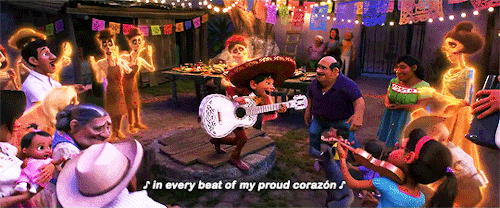This week’s Movie Pick of the Week is a special one. In honor of Día de Los Muertos and the two-year release of the visually stunning tale, Coco. Little did I know that this significantly important film would help me in ways I never imagined.
Día de Los Muertos is a celebration to commemorate the departed lives. Specifically, Mexican culture doesn’t shy away from death; we accept it as a part of life’s cycle.
Coco begins with Miguel (Anthony Gonzalez) narrating the story of his family, the Rivera’s. In particular, chronicling the story of how his great-great-grandfather left behind his wife Imelda and daughter Coco to pursue a music career.
Miguel explains that the fierce Mamá Imelda (as he calls her) doesn’t wallow in her misery. Instead, she finds the strength to pull herself together and learns to make shoes to provide for their daughter. Along with her shoe business, Mamá Imelda establishes a strict ban on all music, which she passes onto generations after.
Viewers then see more of the fictional Mexican town of Santa Cecilia-aptly named for musicians’ patron saint. Addedly, the vibrant representation of the small town reminds me of why I love and adore Mexico.
As viewers are taking in the fictional town and Miguel’s family, we see an earnest glimpse into the relationship between Miguel and his great grandmother Mamá Coco.
Not only did their sweet relationship bring me back to my close-knit kinship with my maternal Abuela, but similar to Coco, my Abuela heartbreakingly didn’t remember who most of us were at times thanks to her dementia.

However, Miguel’s relationship with his Abuelita’s a bit more complicated. Abuelita Elena (Renée Victor) runs the Rivera household as well as business with an iron fist. Or should we say, chancla.
Hence any possible sound resembling music, and we see the wrath of Abuelita’s chancla bringing Miguel back to reality. Abuelita’s profusely use of her chancla’s enough for my niece to whisper, “oh my gosh, that’s Abuela!”.
Subsequently, Miguel’s love of music is his not-so-big secret. He even teaches himself how to play guitar on his homemade contraption by re-watching his hero, Mexican superstar Ernesto de la Cruz’s best films.
Then on Día de Los Muertos, viewers see Miguel (and the fittingly named) Dante (a stray symbolic Xolo dog) accidentally knock over Mama Imelda’s photo off of the ofrenda. Resulting in a shattered picture frame.
Miguel uncovers a possible life-changing secret and assumes his family would be over the moon. Instead, he angers his Abuelita, who then irrationally breaks his beloved secret guitar.
As a result, Miguel runs away and denounces his family for their lack of support. Miguel sprints towards the Santa Cecilia cemetery, hoping to prove his family wrong; he breaks into de la Cruz’s mausoleum to borrow his famed guitar.
Except, as soon as he strums the guitar, he learns that stealing from the dead leads to consequences.
For this reason, Miguel now finds himself invisible among the living.
Panicking and frantic, Miguel repeatedly scurries into once undetectable spirits who are making their way to visit their families for a holiday.
However, viewers see that there’s trouble with the Rivera’s crossing over because of Miguel’s actions. While most of the Rivera’s make it across, mamá Imelda (Alanna Ubach) gets left behind at the border before the bridge made of gorgeously glowing cempasúchil’s (marigolds).
The dazzling metropolis of the Land of the Dead is striking, such colorful imagery inspired by the Mexican city, Guanajuato.
While most cultures avoid talking about the taboo around death— Mexican culture fully embraces it and indulges in its symbolism. Thus the plethora of brightly colored calacas (skeletons) and Calaveras (skulls) everywhere.
As the film goes on, we see more beautiful homages to Mexican culture.
Not only do viewers see Alebrijes (spirit guides), Papel Picado (perforated paper banners), monarch butterflies, La Llorona, La Catrina, and even Miguel’s grito.
Certainly can’t forget appearances of Mexican legends: Emiliano Zapata, El Santo, Agustín Lara, and Frida Kahlo. Also there’s María Félix, Dolores del Río, Cantinflas, Pedro Infante, and Jorge Negrete. Infante and Negrete are even modeled after de la Cruz.

Without divulging too much of the intricate story, I will say the whole movie’s a treat, but my favorite scenes are Miguel’s relationship with Mamá Coco.
I got misty-eyed while watching because Mamá Coco reminds me so much of my Abuelas, especially my paternal Abuela. Sadly, she passed away in 2015, and my paternal Abuela passed in 2016, so it’s no wonder that the film overwhelmingly hit me harder than expected.
Never losing anyone meaningful to me before left me feeling lost. Then I thought, if I never think about it, I never have to deal with it. Until I saw Coco.
Not wanting to be the adult who cries at a kids’ film, I turn away only to see my niece with tears streaming down her beautiful brown face. That’s when I knew it was okay to let go and to feel vulnerable; I held her hand, and we silently cried in the theater.
Before, I avoided feeling any emotional pain. This, in contrast, also meant avoiding joy. Robbing myself moments of peace because I wasn’t accepting of reality seems silly in retrospect. But like the adage, along with the bad also comes the good.
Never fully coming to terms with my abuela’s passing, I was able to accept my grief finally. Plus, now I know that letting go never meant I’d forget them or their memories.
The sensitivity, grace, and charming reassuring message brought me so much comfort, albeit tears, into my life when I needed it most.



